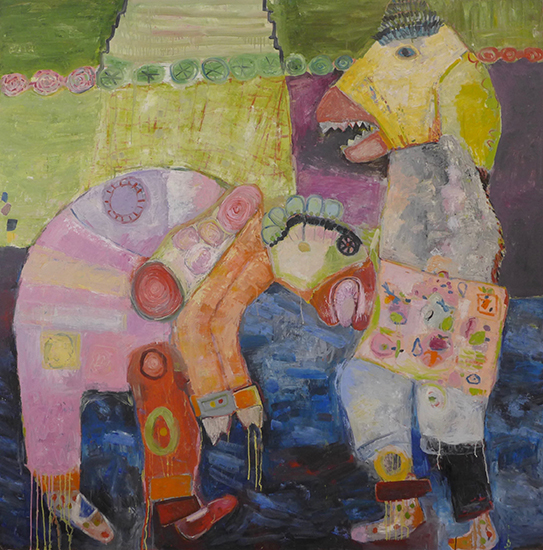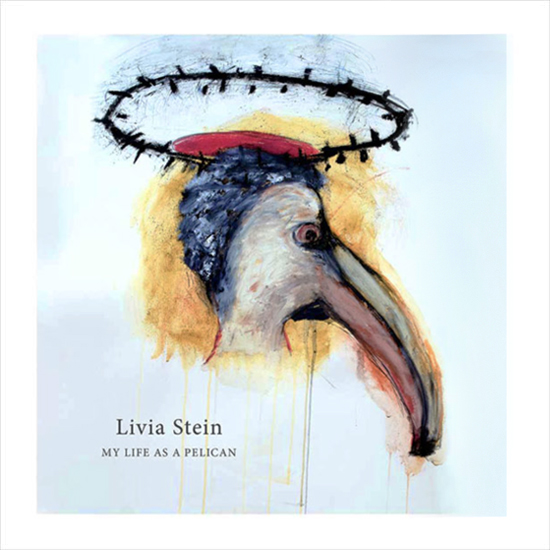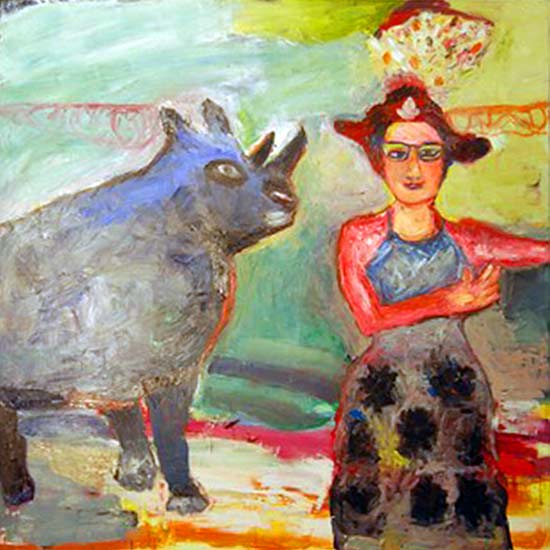NEWS

FEBRUARY 7 - MARCH 21, 2020
Transmission Gallery
770 West Grand Avenue (cross street West Street)
Oakland, CA
(510) 835-2626
Opening Reception: Friday, February 7th, 6-9pm
Transmission Gallery is pleased to present Almost Human, a solo exhibition of recent work by Livia Stein at 770 West Grand Avenue, Oakland, CA, from February 7th through March 21st, 2020. The reception for the artist, which is open to the public, will be held on Friday, February 7th, from 6-9 p.m.
PUBLICATION

LIVIA STEIN CATALOG 2018
Synesthesia is a word for the state of having one’s five senses confused, one might hear a sunset, or smell a color. The vibrant recent work of artist Livia Stein is a joyous invitation to do just that, to experience the art of painting using all five of one’s senses, in any order one chooses.
— Excerpt from Barbara Morris, 2018 from the catalog
Livia Stein, My Life as a Pelican.
Catalog available for sale at Transmission Gallery.
REVIEWS

VAS VISUAL ART SOURCE 2016
VAS Visual Art Source
Looking at this show of new work by long-time Bay Area artist Livia Stein gave me pause to question the sanity of whatever admonishing eyes would ever proclaim that “painting is dead.” It’s never been true, as far as I can tell, and it never will be; it certainly isn’t now. And thank all that gives me pleasure! Because when I see great painting, as I did here, I can’t get enough. That’s why I lingered, and lingered, and lingered over the works in Stein’s current show. They are just that good, that fun, that layered. Humor? Yes. Color theory, absolutely! Painterliness, as you don’t often see? Oh, yes!
To be sure there is also ceramic sculpture, mixed media on paper, carborundum prints and monotypes that display the reach of Stein’s talent. I do enjoy these other works, but I just kept coming back to her paintings and the lively brushwork that lends them strong and energetic movement. Her colors are adventurous and ambitious, mixing together dull and loud. This is so obviously a painter who owns her palette. She paints slightly gross characters who you soon love, with weird teeth but all pink about them. And you get lost in that really fun way that great paintings draw you in. You want to stay with a weird creature you’re looking at, that one with the strange teeth or big hat, but then you get drawn back into brilliant color fields or brush strokes, alive with how the painter touched down and mixed with it up with a brush. My goodness, that’s the good stuff.
— Transmission Gallery, Oakland, CA
Recommendation by Cherie Louise Turner

DeWITT CHENG, FEBRUARY 8, 2014
Better Late Than Never Department. Said I’d review this Sanchez Art Center show of Livia Stein and Elisabeth Higgins O’Connor. Last day of show is tomorrow. Talk with artist/s, curators at 4pm. — Cautionary Tales Reconsidered
Sanchez Art Center, Pacifica CA
January 10- February 9, 2014
Rumors of the death of art (even from esteemed art critics) notwithstanding, there is, if anything, more art activity in the Bay Area nowadays than anyone can reasonably digest.
The unfortunate result of the embarrassment of riches is that shows come and go in four or six weeks, and viewers are simply too overwhelmed to prioritize and exercise due diligence. Fortunately, a show that opened last year at Oakland’s Transmission Gallery, Cautionary Tales, featuring the paintings of Livia Stein and the sculptures of Elisabeth Higgins O’Connor, has been granted a second life, with a sequel exhibition at the Sanchez Art Center in Pacifica, Cautionary Tales Reconsidered, which adds new work to the mix. Both shows were curated by Transmission Gallery’s Ruth Santee and Cameron Brian, both artists themselves.
The whimsical, extravagant fairy-tale tone of the original show remains the same, however. What is a cautionary tale?
A cautionary tale is a tale told in folklore to warn its hearer of a danger. There are three essential parts to a cautionary tale, though they can be introduced in a large variety of ways. First, a taboo or prohibition is stated: some act, location, or thing is said to be dangerous. Then, the narrative itself is told: someone disregarded the warning and performed the forbidden act. Finally, the violator comes to an unpleasant fate, which is frequently related in expansive and grisly detail. (Wikipedia)
Stein and O’Connor treat this moral-lesson theme light-heartedly, with humorous gusto, without excluding its dark side—remember how gory the Grimms and Andersen can be—but not succumbing to it, either. The balanced tone of their take on folklore (in this case, personal, invented folklores) may remind viewers of Steven Sondheim’s darkly funny, sad and wise musical, “Into the Woods.” Joseph Campbell’s books on mythology and his televised interviews with Bill Moyers make a powerful case for the relevance of myth and fantasy in even an ostensibly scientific, rationalist culture. Of course, American society is hardly that; perhaps things improve if we learned to distinguish between the two—as art, powerful and affecting but clearly invented, teaches us to do. (The postmodernist guru’s notion that we cannot tell the difference, and need always to be reminded of the artifice of art, is absurd and self-serving.)
Stein in her heavily worked oil paintings employs abstract expressionist ‘attack’ (i.e., process and gesture) to create a personal mythology; her protagonists, human or animal or hybrid, emerge from the painterly matrix and, however fanciful, embody painterly, material weight and substance. Four mixed-media drawings of Pinocchio set the tone as the viewer enters the gallery; if moral lessons may possibly be learned from Collodi’s (and Disney’s) puppet boy-man, he’s also a colorful and engaging character despite his loose-jointed situational ethics; in Stein’s depictions, he’s as weightless and malleable as any casual consumer of Madison Avenue’s received Pleasure-Island wisdoms. Stein’s love of the work of Guston and perhaps Goya becomes apparent in oils like “Man with Tree,” a square-format work depicting a puppet- or clownlike figure leaning, his tongue protruding, against an anthropomorphized tree trunk with an eye-like knothole and stubby, undeveloped limbs; his arms are extended behind, up the trunk, as if tied, and his legs fade into the background sky, while a small dog or fox floats nearby, nuzzling his head. Counteracting the ambiguity of the imagery are Stein’s bold brushwork and rich color; Stein’s pictorial authority compels the suspension of viewer disbelief. Three large paintings hung together, “Man in Blue,” “Red Pinocchio” and “The Mouth” (with its disembodied open maws) are likewise visually resonant, even if they defy (or defer, infinitely) conventional narrative. In the hilariously entitled “Orange Crocodile Interacts with Man’s Nose,” another clown figure appears, this one apparently about to lose his pointed nose to an avid ursine dinosaur. In Stein’s anti-Disney world, innocence and menace are never far apart.
The sinister and comical combine as well in O’Connor’s huge, fanciful figurative sculptures. Crafted from countless bits of cloth and paper affixed to wooden structures, they suggest the gigantic puppets used in traditional ceremonies in older cultures, and it is possible to imagine them used to extort good behavior from small children (although the children who attended the reception seemed visibly charmed). The marshaling of such, everyday humble materials as cardboard, wood, paper, bed sheets, glue, paint, drywall screws, sandbags, blankets, packing blankets, blankets, bed sheets, towels, bath rugs, glue, paint, and thread, along with resin and acrylic paint lends these works an air of casual improbability, and of animation by magic, like sorcerer-apprentice Mickey’s water-carrying broomstick slaves. There’s a hint of Mike Kelley’s abject stuffed toys, too, in “no name (flower footed),” “50ft queenie,” with their monument-sized bipedal canines and “Nevertheless,” my favorite, a club-footed corvine in which the genes of Poe’s raven and Kozinski’s (and Bosch’s) painted humanoid birds magically combine.
— DeWitt Cheng

KENNETH BAKER, JULY 29, 2010
SF Gate
As I looked through “Local Treasures: Six Extraordinary Artists” at the Berkeley Art Center, a coolly delivered but frightening line from Laurie Anderson’s “O, Superman” buzzed in my head: “Here come the planes!” Perhaps curators Suzanne Tan and Richard…
— Kenneth Baker
SF Gate

DAVID M. ROTH, JULY 11, 2010
SquareCylinder.com
As I looked through “Local Treasures: Six Extraordinary Artists” at the Berkeley Art Center, a coolly delivered but frightening line from Laurie Anderson’s “O, Superman” buzzed in my head: “Here come the planes!” Perhaps curators Suzanne Tan and Richard…”
— David M. Roth

DeWITT CHENG, JULY 7, 2010
eastbayexpress.com
Work Life: The Berkeley Art Center honors six eminent East Bay artists
“Robert Brady, Squeak Carnwath, Jim Melchert, Katherine Sherwood, Livia Stein, and Gale Wagner are respected, established artists and teachers, so aficionados may recognize their works in Local Treasures…”
— DeWitt Cheng

JENNIFER MODENESSI, JUNE 29, 2010
Contra Costa Times
Conversations with artists help “Treasures” shine
“GAZING AT sculptor Gale Wagner’s delicate airplanes dangling from the wood beams of the Berkeley Art Center, I was both fascinated and intrigued…”
— Jennifer Modenessi



